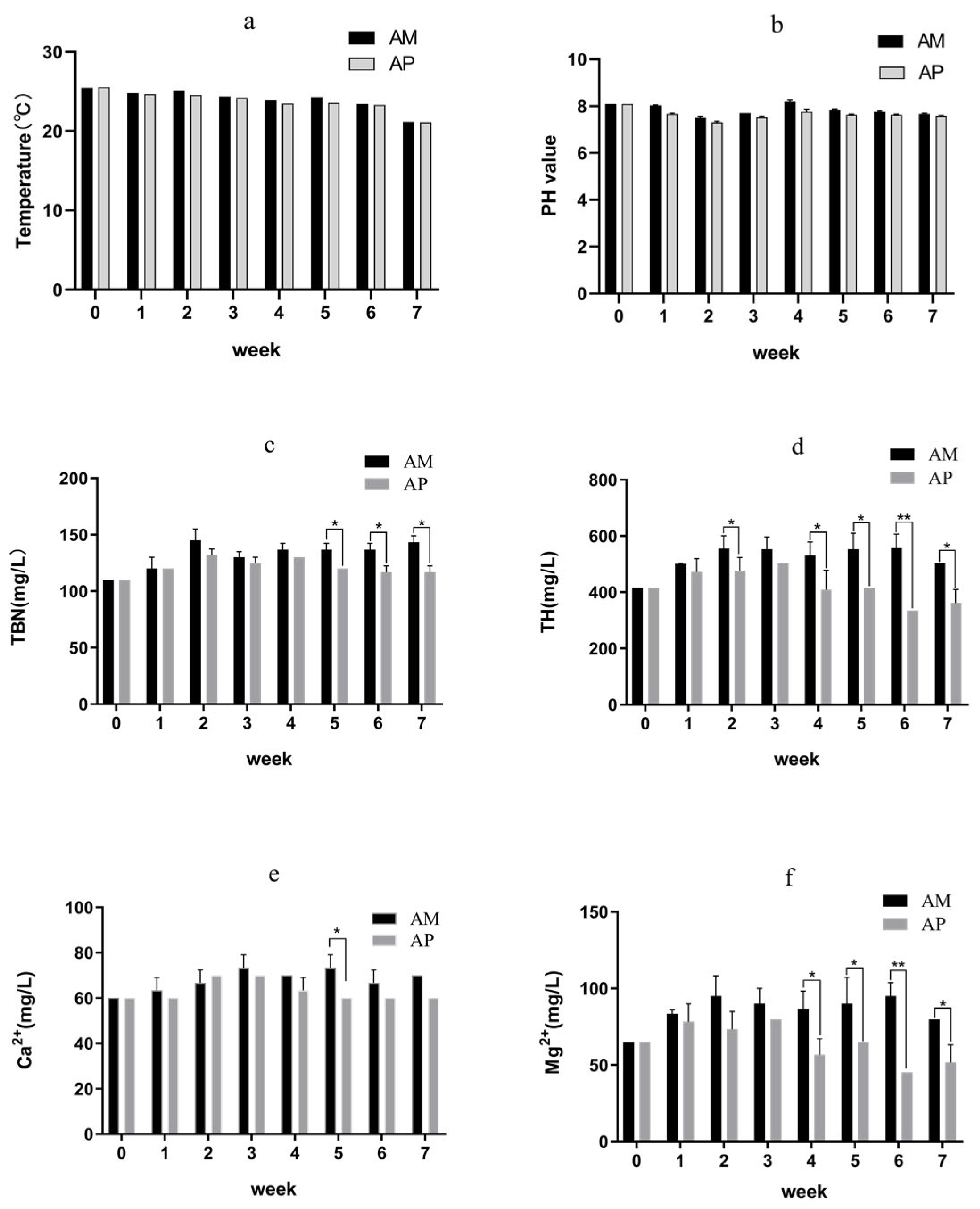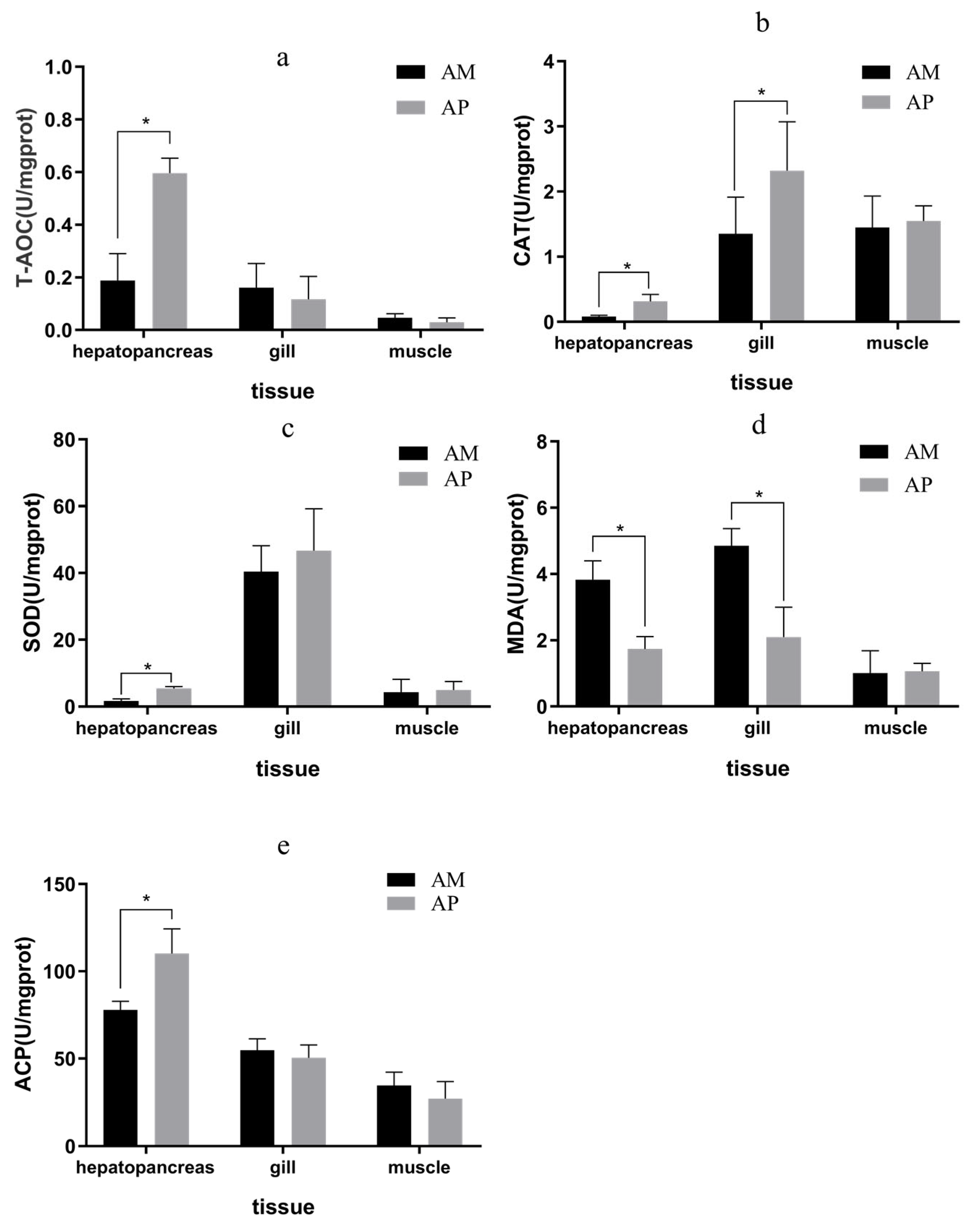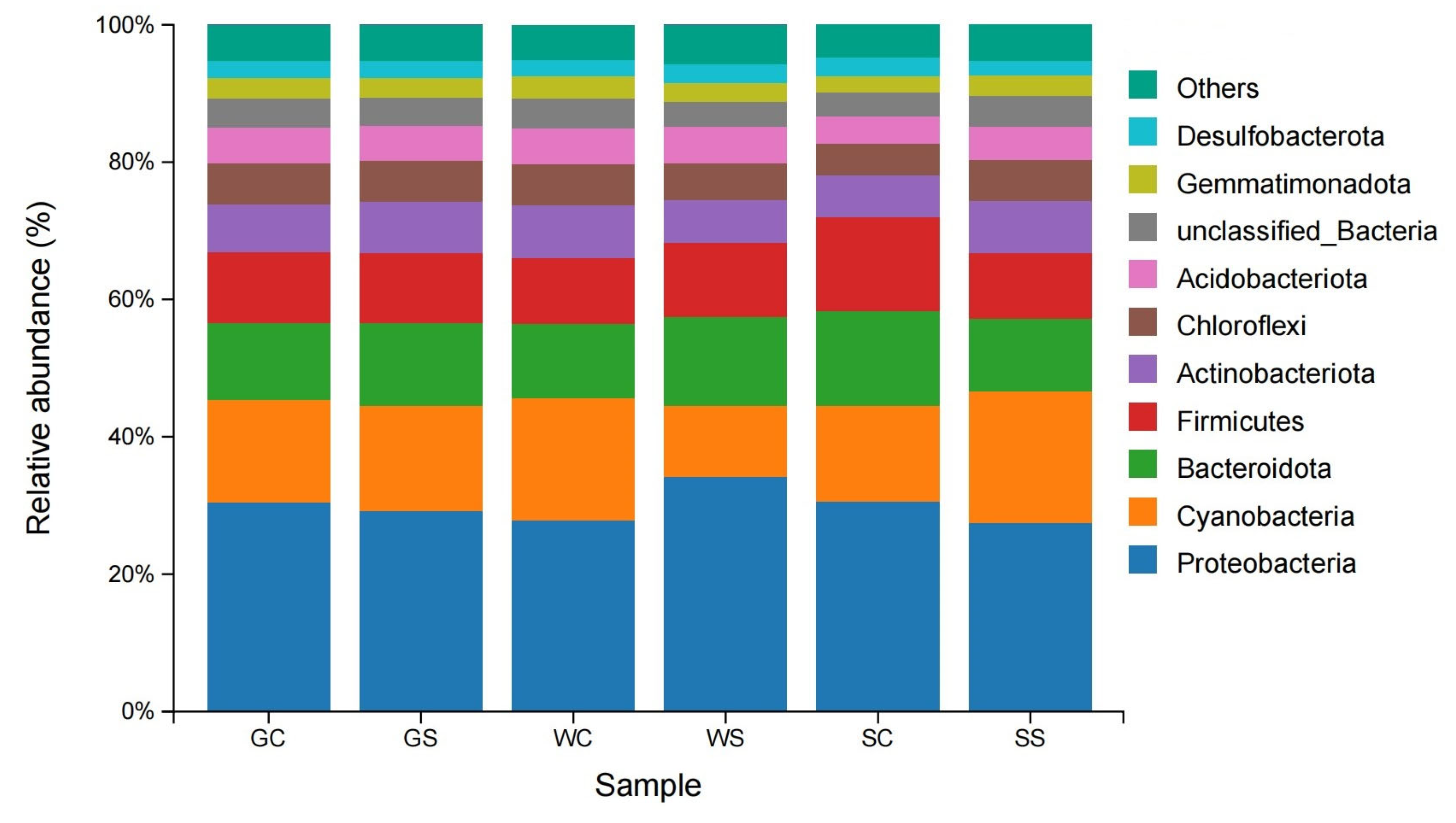Effect of an Ipomoea aquatica Floating Raft on the Water Quality, Antioxidant System, Non-Specific Immune Responses, and Microbial Diversity of Penaeus vannamei in an Aquaculture System
Abstract
1. Introduction
2. Materials and Methods
2.1. Pond and Shrimp–Water Spinach Raft Aquaponics System Design
2.2. Water Sample Collection and Measurement of Temperature, pH, TBN, TH, Ca2+, Mg2+, TP, TN, NO3−-N, NH4+-N, NO2−-N, and AP
2.3. Growth of P. vannamei and I. aquatica
2.4. Analysis of Antioxidant and Immune Responses of P. vannamei
2.5. Microbial Diversity and Abundance Analysis
2.6. Data Analysis
3. Results
3.1. A Water Spinach Floating Raft Can Improve the Water Quality of a Shrimp Culture
3.2. The Water Spinach Raft Aquaponics System Improved the Production Performance of Shrimp
3.3. The Antioxidant and Non-Specific Immune Response of Shrimp Were Improved in the AP System
3.4. The Microbial Diversity and Abundance Analysis Were Different between the AP and AM Systems
4. Discussion
5. Conclusions
Author Contributions
Funding
Institutional Review Board Statement
Data Availability Statement
Conflicts of Interest
References
- Shen, X.; Xu, M.; Li, M.; Zhao, Y.; Shao, X. Response of sediment bacterial communities to the drainage of wastewater from aquaculture ponds in different seasons. Sci. Total Environ. 2020, 717, 137180. [Google Scholar] [CrossRef] [PubMed]
- Cashion, T.; Le Manach, F.; Zeller, D.; Pauly, D. Most fish destined for fishmeal production are food-grade fish. Fish Fish. 2017, 18, 837–844. [Google Scholar] [CrossRef]
- Kumar, V.J.R.; Joseph, V.; Philip, R.; Singh, I.S.B. Nitrification in brackish water recirculating aquaculture system integrated with activated packed bed bioreactor. Water Sci. Technol. 2010, 61, 797–805. [Google Scholar] [CrossRef] [PubMed]
- Buck, B.H.; Troell, M.F.; Krause, G.; Angel, D.L.; Grote, B.; Chopin, T. State of the Art and Challenges for Offshore Integrated Multi-Trophic Aquaculture (IMTA). Front. Mar. Sci. 2018, 5, 165. [Google Scholar] [CrossRef]
- Maity, A.; Saha, B.; Pandit, A.; Patra, P. Farming practices of Litopenaeus vannamei: An empirical study in West Bengal, India. J. Inland Fish. Soc. India 2021, 53, 101–108. [Google Scholar] [CrossRef]
- BRATTELER, M.; BALTISBERGER, M.; WIDMER, A. QTL Analysis of Intraspecific Differences between Two Silene vulgaris Ecotypes. Ann. Bot. 2006, 98, 411–419. [Google Scholar] [CrossRef] [PubMed]
- Bouwman, L.; Goldewijk, K.K.; Van Der Hoek, K.W.; Beusen, A.H.W.; Van Vuuren, D.P.; Willems, J.; Rufino, M.C.; Stehfest, E. Exploring global changes in nitrogen and phosphorus cycles in agriculture induced by livestock production over the 1900–2050 period. Proc. Natl. Acad. Sci. USA 2013, 110, 20882–20887. [Google Scholar] [CrossRef] [PubMed]
- Johannes, S.; Slamet Budi, H. White Shrimp (Litopenaeus vannamei) Culture using Heterotrophic Aquaculture System on Nursery Phase. Int. J. Waste Resour. 2014, 4. [Google Scholar] [CrossRef]
- Ruan, Z.; Jiang, L.; Li, Y.; Lu, Z.; Chen, X.; Zhang, X.; Liu, W. Transcriptomic analysis of the immune response against A. hydrophila infection in striped catfish Pangasianodon hypophthalmus. Aquaculture 2022, 547, 737446. [Google Scholar] [CrossRef]
- Liu, Y.; Ren, T.; Xu, G.; Teng, H.; Liu, B.; Yu, Y. Effects of micro- and nano-plastics on accumulation and toxicity of pyrene in water spinach (Ipomoea aquatica Forsk). Environ. Sci. Pollut. Res. 2023, 30, 956–965. [Google Scholar] [CrossRef] [PubMed]
- Ibrahim, M.H.; Abas, N.A.; Zahra, S.M. Impact of Salinity Stress on Germination of Water Spinach (Ipomoea aquatica). Annu. Res. Rev. Biol. 2019, 31, 1–12. [Google Scholar] [CrossRef]
- Jamali, S.; Sajadi, F.; Hezarjaribi, A. Feasibility of Using Caspian Seawater to Irrigate Spinach (Spinacia oleracea L.). J. Water Irrig. Manag. 2020, 9, 263–275. [Google Scholar] [CrossRef]
- Luo, Y.; Chen, X.; Xie, R.; Ruan, Z.; Lu, Z.; Jiang, L.; Li, Y.; Liu, W. The Effect of Water Spinach on the Water Quality, Antioxidant System, Non-Specific Immune Response, Growth Performance, and Carbon Balance in Red Tilapia Production. Fishes 2023, 8, 515. [Google Scholar] [CrossRef]
- Zainal Alam, M.N.H.; Kamaruddin, M.J.; Adzila, S.; Nordin, N.; Othman, R. Solar-powered aquaponics prototype as sustainable approach for food production. Mater. Today Proc. 2022, 65, 2953–2959. [Google Scholar] [CrossRef]
- Tarján, Z.; Pénzes, J.; Tóth, R.; Benkő, M. First detection of circovirus-like sequences in amphibians and novel putative circoviruses in fishes. Acta Vet. Hung. 2013, 62, 134–144. [Google Scholar] [CrossRef] [PubMed]
- Magoč, T.; Salzberg, S.L. FLASH: Fast length adjustment of short reads to improve genome assemblies. Bioinformatics 2011, 27, 2957–2963. [Google Scholar] [CrossRef] [PubMed]
- Edgar, R.C. UPARSE: Highly accurate OTU sequences from microbial amplicon reads. Nat. Methods 2013, 10, 996–998. [Google Scholar] [CrossRef] [PubMed]
- Belivermiş, M.; Besson, M.; Swarzenski, P.; Oberhaensli, F.; Taylor, A.; Metian, M. Influence of pH on Pb accumulation in the blue mussel, Mytilus edulis. Mar. Pollut. Bull. 2020, 156, 111203. [Google Scholar] [CrossRef] [PubMed]
- Shu, H.; Ma, Y.; Lu, H.; Sun, H.; Zhao, J.; Ruan, Z.; Zhou, J.; Liu, Y.; Liu, F.; Xu, J.; et al. Simultaneous aerobic nitrogen and phosphate removal capability of novel salt-tolerant strain, Pseudomonas mendocina A4: Characterization, mechanism and application potential. Bioresour. Technol. 2024, 393, 130047. [Google Scholar] [CrossRef]
- Zhang, C.; Zhao, Y.; Xu, M.; Zheng, W.; Zhao, Y.; Qin, B.; Wang, R. Revealing the hidden burden for lake management: The sediment phosphorus storage pools in Eastern Plain Lake Zone, China. Environ. Sci. Pollut. Res. 2023, 30, 116052–116065. [Google Scholar] [CrossRef]
- Cao, X.; Song, C.; Xiao, J.; Zhou, Y. The Optimal Width and Mechanism of Riparian Buffers for Storm Water Nutrient Removal in the Chinese Eutrophic Lake Chaohu Watershed. Water 2018, 10, 1489. [Google Scholar] [CrossRef]
- Gu, X.; Chen, D.; Wu, F.; Tang, L.; He, S.; Zhou, W. Function of aquatic plants on nitrogen removal and greenhouse gas emission in enhanced denitrification constructed wetlands: Iris pseudacorus for example. J. Clean. Prod. 2022, 330, 129842. [Google Scholar] [CrossRef]
- Marcussen, H.; Dalsgaard, A.; Holm, P.E. Element concentrations in water spinach (Ipomoea aquatica Forssk.), fish and sediment from a wetland production system that receives wastewater from Phnom Penh, Cambodia. J. Environ. Sci. Health. Part A Toxic/Hazard. Subst. Environ. Eng. 2009, 44, 67–77. [Google Scholar] [CrossRef]
- Harris, J.O.; Maguire, G.B.; Edwards, S.; Hindrum, S.M. Effect of ammonia on the growth rate and oxygen consumption of juvenile greenlip abalone, Haliotis laevigata Donovan. Aquaculture 1998, 160, 259–272. [Google Scholar] [CrossRef]
- Zhao, M.; Yao, D.; Li, S.; Zhang, Y.; Aweya, J.J. Effects of ammonia on shrimp physiology and immunity: A review. Rev. Aquacult 2020, 12, 2194–2211. [Google Scholar] [CrossRef]
- Wongsasak, U.; Chaijamrus, S.; Kumkhong, S.; Boonanuntanasarn, S. Effects of dietary supplementation with β-glucan and synbiotics on immune gene expression and immune parameters under ammonia stress in Pacific white shrimp. Aquaculture 2015, 436, 179–187. [Google Scholar] [CrossRef]
- Tu, P.; Hai, V.; Lien, N.; Diep, D. Evaluation of short-term toxicity of ammonia and nitrite on the survival of whiteleg shrimp, Litopenaeus vannamei juveniles. Isr. J. Aquac. 2022, 74, 66875. [Google Scholar] [CrossRef]
- Rajagopal, S.; Bukhov, N.G.; Carpentier, R. Photoinhibitory Light-induced Changes in the Composition of Chlorophyll-Protein Complexes and Photochemical Activity in Photosystem-I Submembrane Fractions. Photochem. Photobiol. 2003, 77, 284–291. [Google Scholar] [CrossRef]
- Alam, M.; Yasmin, H.; Hossain, M.; Alam, M.S. Potentials of Integrating Fish Culture with Floating Bed Vegetable Production in Closed Pond System. Bangladesh J. Sci. Res. 2020, 31–33, 96–103. [Google Scholar]
- Zhang, X.; Wang, J.; Tang, R.; He, X.; Li, L.; Takagi, Y.; Li, D. Improvement of Muscle Quality of Grass Carp (Ctenopharyngodon idellus) With a Bio-Floating Bed in Culture Ponds. Front. Physiol. 2019, 10, 683. [Google Scholar] [CrossRef] [PubMed]
- Ben Seghir, B.; Kouadri, I.; Messaoudi, M.; Rebiai, A.; Zeghoud, S.; Hemmami, H.; Ben Amor, I. Food Chain Contamination and Impact of Xenobiotics on Human Health. In Xenobiotics in Urban Ecosystems; Springer: Cham, Germany, 2023; pp. 109–129. [Google Scholar]
- Jordán, J.; Saez-atienzar, S.; Atienzar, S.; Solesio, M.; Galindo, M. Pharmacology and Pathology of Superoxide Dismutases (SOD). In Systems Biology of Free Radicals and Antioxidants; Springer: Berlin/Heidelberg, Germany, 2014; pp. 457–474. [Google Scholar]
- Ighodaro, O.M.; Akinloye, O.A. First line defence antioxidants-superoxide dismutase (SOD), catalase (CAT) and glutathione peroxidase (GPX): Their fundamental role in the entire antioxidant defence grid. Alex. J. Med. 2018, 54, 287–293. [Google Scholar] [CrossRef]
- Xu, J.; Zhao, T.; Luo, Z.; Zhong, C.; Zheng, H.; Tan, X. Effects of dietary supplementation with manganese dioxide nanoparticles on growth, Mn metabolism and kidney health of yellow catfish Pelteobagrus fulvidraco. Aquacult Rep. 2023, 33, 101815. [Google Scholar] [CrossRef]
- Chen, C.; Hsieh, C. Effect of Acupuncture on Oxidative Stress Induced by Cerebral Ischemia-Reperfusion Injury. Antioxidants 2020, 9, 248. [Google Scholar] [CrossRef] [PubMed]
- Bao, H.; Zhang, S.; Tang, C.; Yang, X. Effect of dam construction on spawning activity of Yellow River carp (Cyprinus carpio) in the lower Yellow River. Front. Earth Sci. 2022, 10, 1114448. [Google Scholar] [CrossRef]
- Xu, Y.; Li, L.; Lou, S.; Tian, J.; Sun, S.; Li, X.; Li, Y. Effects of Nano-Aerators on Microbial Communities and Functions in the Water, Sediment, and Shrimp Intestine in Litopenaeus vannamei Aquaculture Ponds. Microorganisms 2022, 10, 1302. [Google Scholar] [CrossRef] [PubMed]
- Sirotkin, A.S.; Kobeleva, J.V.; Gorshkova, E.S. Bio-Augmentation of Nitrifying Microorganisms to Increase the Efficiency of Oxidation of Nitrogen Compounds during Wastewater Biofiltration. Biotekhnologiya 2020, 36, 99–107. [Google Scholar] [CrossRef]
- Tang, Y.; Tao, P.; Tan, J.; Mu, H.; Peng, L.; Yang, D.; Tong, S.; Chen, L. Identification of Bacterial Community Composition in Freshwater Aquaculture System Farming of Litopenaeus vannamei Reveals Distinct Temperature-Driven Patterns. Int. J. Mol. Sci. 2014, 15, 13663–13680. [Google Scholar] [CrossRef] [PubMed]
- Li, X.; Yang, L.; Jiang, S.; Zhou, F.; Jiang, S.; Li, Y.; Chen, X.; Yang, Q.; Duan, Y.; Huang, J. Effect of Fly Maggot Protein as Dietary on Growth and Intestinal Microbial Community of Pacific White Shrimp Litopenaeus vannamei. Biology 2023, 12, 1433. [Google Scholar] [CrossRef] [PubMed]
- Zhao, S.; Ma, L.; Wang, Y.; Fu, G.; Zhou, J.; Li, X.; Fang, W. Antimicrobial resistance and pulsed-field gel electrophoresis typing of Vibrio parahaemolyticus isolated from shrimp mariculture environment along the east coast of China. Mar. Pollut. Bull. 2018, 136, 164–170. [Google Scholar] [CrossRef] [PubMed]
- Xu, H.; Wang, L.; Bao, X.; Jiang, N.; Yang, X.; Hao, Z.; Chang, Y.; Ding, J. Microbial communities in sea cucumber (Apostichopus japonicus) culture pond and the effects of environmental factors. Aquac. Res. 2019, 50, 1257–1268. [Google Scholar] [CrossRef]
- Durand, L.; Zbinden, M.; Cueff-Gauchard, V.; Duperron, S.; Roussel, E.G.; Shillito, B.; Cambon-Bonavita, M.A. Microbial diversity associated with the hydrothermal shrimp Rimicaris exoculata gut and occurrence of a resident microbial community. FEMS Microbiol. Ecol. 2010, 71, 291–303. [Google Scholar] [CrossRef] [PubMed]
- Laverock, B.; Smith, C.J.; Tait, K.; Osborn, A.M.; Widdicombe, S.; Gilbert, J.A. Bioturbating shrimp alter the structure and diversity of bacterial communities in coastal marine sediments. ISME J. 2010, 4, 1531–1544. [Google Scholar] [CrossRef] [PubMed]
- Zhou, L.; Qu, Y.; Qin, J.G.; Chen, L.; Han, F.; Li, E. Deep insight into bacterial community characterization and relationship in the pond water, sediment and the gut of shrimp (Penaeus japonicus). Aquaculture 2021, 539, 736658. [Google Scholar] [CrossRef]
- Jena, P.K.; Sheng, L.; Nagar, N.; Wu, C.; Barile, D.; Mills, D.A.; Wan, Y.Y. The effect of synbiotics Bifidobacterium infantis and milk oligosaccharides on shaping gut microbiota community structure and NASH treatment. Data Brief. 2018, 19, 1025–1029. [Google Scholar] [CrossRef] [PubMed]





| Data per Pond | AP Water Spinach | AP Shrimp | AM Shrimp |
|---|---|---|---|
| Initial weight (g/pond) | 231 ± 5.507 | 0.089 ± 0.0102 | 0.089 ± 0.0102 |
| First harvest weight (g/pond) | 1640.6 ± 52.201 | / | / |
| Final weight (g/pond) | 1206.3 ± 40.869 | 1.878 ± 0.178 a | 1.166 ± 0.376 b |
| Relative growth rate (%) | 1232.03 | 2110.11 a | 1310.11 b |
| Survival rate (%) | 100 | 76 a | 71 b |
| Total harvest weight (g) | 8538 | 142.728 a | 82.786 b |
| Sample | Groups | Phylum | Class | Order | Family | Genus | Species |
|---|---|---|---|---|---|---|---|
| Gut | AP system | 34 | 87 | 222 | 377 | 619 | 664 |
| AM system | 32 | 84 | 210 | 393 | 594 | 638 | |
| Water | AP system | 37 | 92 | 244 | 434 | 720 | 780 |
| AM system | 34 | 87 | 209 | 372 | 588 | 664 | |
| Sediment | AP system | 38 | 87 | 217 | 386 | 612 | 780 |
| AM system | 33 | 81 | 206 | 372 | 573 | 638 |
| Index | Sample | AP | AM |
|---|---|---|---|
| Shannon–Wiener index | Guts | 8.7425 a | 8.5342 b |
| Water | 8.9987 a | 8.8721 b | |
| Sediment | 9.5536 a | 8.7655 b | |
| Simpson index | Guts | 0.9695 a | 0.9740 a |
| Water | 0.9785 a | 0.9768 b | |
| Sediment | 0.9919 a | 0.9792 b |
Disclaimer/Publisher’s Note: The statements, opinions and data contained in all publications are solely those of the individual author(s) and contributor(s) and not of MDPI and/or the editor(s). MDPI and/or the editor(s) disclaim responsibility for any injury to people or property resulting from any ideas, methods, instructions or products referred to in the content. |
© 2024 by the authors. Licensee MDPI, Basel, Switzerland. This article is an open access article distributed under the terms and conditions of the Creative Commons Attribution (CC BY) license (https://creativecommons.org/licenses/by/4.0/).
Share and Cite
Ruan, Z.; Xie, R.; Li, Y.; Luo, Y.; Weng, Z.; Liu, W. Effect of an Ipomoea aquatica Floating Raft on the Water Quality, Antioxidant System, Non-Specific Immune Responses, and Microbial Diversity of Penaeus vannamei in an Aquaculture System. Fishes 2024, 9, 175. https://doi.org/10.3390/fishes9050175
Ruan Z, Xie R, Li Y, Luo Y, Weng Z, Liu W. Effect of an Ipomoea aquatica Floating Raft on the Water Quality, Antioxidant System, Non-Specific Immune Responses, and Microbial Diversity of Penaeus vannamei in an Aquaculture System. Fishes. 2024; 9(5):175. https://doi.org/10.3390/fishes9050175
Chicago/Turabian StyleRuan, Zhuohao, Ruilin Xie, Yifu Li, Yuanyuan Luo, Zufeng Weng, and Wensheng Liu. 2024. "Effect of an Ipomoea aquatica Floating Raft on the Water Quality, Antioxidant System, Non-Specific Immune Responses, and Microbial Diversity of Penaeus vannamei in an Aquaculture System" Fishes 9, no. 5: 175. https://doi.org/10.3390/fishes9050175
APA StyleRuan, Z., Xie, R., Li, Y., Luo, Y., Weng, Z., & Liu, W. (2024). Effect of an Ipomoea aquatica Floating Raft on the Water Quality, Antioxidant System, Non-Specific Immune Responses, and Microbial Diversity of Penaeus vannamei in an Aquaculture System. Fishes, 9(5), 175. https://doi.org/10.3390/fishes9050175







